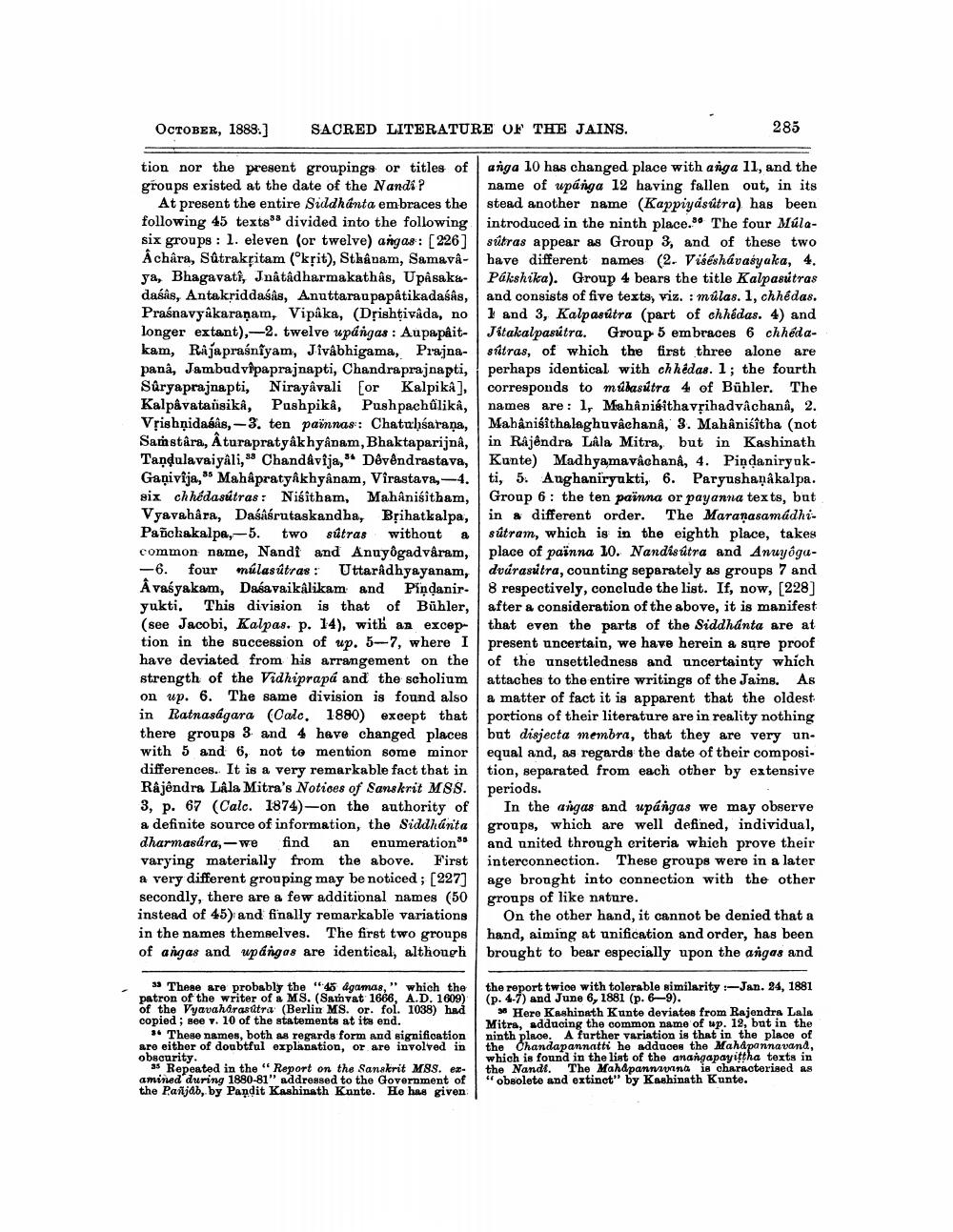________________
OCTOBER, 1888:]
SACRED LITERATURE OF THE JAINS.
285
tion nor the present groupings or titles of anga 10 has changed place with anga ll, and the groups existed at the date of the Nandi ? name of upanga 12 having fallen out, in its
At present the entire Siddhanta embraces the stead another name (Kappiyasútra) has been following 45 texts divided into the following introduced in the ninth place. The four Múlasix groups: 1. eleven (or twelve) angas: [226] sútras appear as Group 3, and of these two A châra, Satrakritam ("kpit), Sthanam, Samavâ- bave different names (2. Viséshávasyaka, 4. ya, Bhagavatî, Jnåtâdharmakathâs, Upasaka Pákshika). Group 4 bears the title Kalpasutras daśas, Antakriddaśas, Anuttaraupapatikadaśás, and consists of five texts, viz. : múlas. 1, chhedas. Praśnavyâkaraṇam, Vipaka, (Drishtivada, no 1 and 3, Kalpasútra (part of chhedas. 4) and longer extant),2. twelve upangas: Aupapait- Jitakalpasútra. Group 5 embraces 6 chhedakam, Rajapraśniyam, Jivabhigama, Prajna- stras, of which the first three alone are pana, Jambadvipaprajnapti, Chandraprajnapti, perhaps identical with chhedas. 1; the fourth Süryaprajnapti, Nirayávali [or Kalpika), corresponds to múbasútra 4 of Bühler. The Kalpâvataisika, Pashpika, Pushpachůlika, names are: 1, Mahậnisithavșihadvachana, 2. Vrishạidabas,-3. ten painnas: Chatuhšarana, Mahani ithalaghuvachana, 3. Mahậniśîtha (not Samstara, Aturapratyakhyânam, Bhaktaparijnâ, | in Rajendra Lala Mitra, but in Kashinath Tandulavaiyali, ss Chand&vija, Dévêndrastava, Kunte) Madhyamavâchana, 4. PiņdaniryukGaņivija, Mahåpratyakhyanam, Vîrastava,-4. ti, 5. Anghaniryakti, 6. Paryushanåkalpa. six chhedasútras: Niśitham, Mahâniśitham, Group 6: the ten painna or payanna texts, but Vyavahara, Daśášrutaskandha, Brihatkalpa, in a different order. The MaranasamadhiPanchakalpa,-5. two sútras without a sútram, which is in the eighth place, tal common name, Nandt and Anuyôgad våram, I place of pažnna 10. Nandisutra and Anuyóga-6. four múlasútras: Uttaradhyayanam, dvárasútra, counting separately as groups 7 and Å vasyakam, Daśavaikalikam and Piņdanir. 8 respectively, conclude the list. If, now, [228] yukti. This division is that of Bühler, after a consideration of the above, it is manifest (see Jacobi, Kalpas. p. 14), with an excep that even the parts of the Siddhanta are at tion in the succession of up. 5-7, where I present uncertain, we have herein a gure proof have deviated from his arrangement on the of the unsettledness and uncertainty which strength of the Vidhiprapá and the scholium attaches to the entire writings of the Jains. As on up. 6. The same division is found also | a matter of fact it is apparent that the oldest in Ratnasagara (Calc. 1880) except that portions of their literature are in reality nothing there groups 3 and 4 have changed places but disjecta membra, that they are very un. with 5 and 6, not to mention some minor equal and, as regards the date of their composidifferences. It is a very remarkable fact that in tion, separated from each other by extensive Rajendra Lala Mitra's Notices of Sanskrit M88. periods. 3, p. 67 (Calc. 1874)-on the authority of In the angas and upángas we may observe a definite source of information, the Siddhanta groups, which are well defined, individual, dharmasúra, -we find an enumeration and united throngh criteria which prove their varying materially from the above. First interconnection. These groups were in a later a very different grouping may be noticed ; [227] age bronght into connection with the other secondly, there are a few additional names (50 groups of like nature. instead of 45) and finally remarkable variations On the other hand, it cannot be denied that a in the names themselves. The first two groups hand, aiming at unification and order, has been of angas and upangas are identical, although brought to bear especially upon the angas and
33 These are probably the " 45 agamas," which the patron of the writer of a MS. (Saṁvat 1666, A.D. 1609) of the Vyavaharasutra (Berlin MS. or. fol. 1038) had copied ; see v. 10 of the statements at its end.
** These names, both as regards form and signification are either of doubtful explanation, or are involved in obscurity.
35 Repeated in the "Report on the Sanskrit MSS. etc. amined during 1880-81" addressed to the Government of the Panjab, by Pandit Kashinath Kante. He has given
the report twice with tolerable similarity :-Jan. 24, 1881 (p. 4-7) and June 6, 1881 (p. 6–9).
98 Here Kashinath Kunte deviates from Rajendra Lala Mitra, adducing the common name of up. 12, but in the ninth place. A further variation is that in the place of the Chandapannatti he adduces the Mahapannavand, which is found in the list of the anangapayittha texts in the Nandi. The Mahapannuna is characterised as "obsolete and extinct" by Kashinath Kunte.




